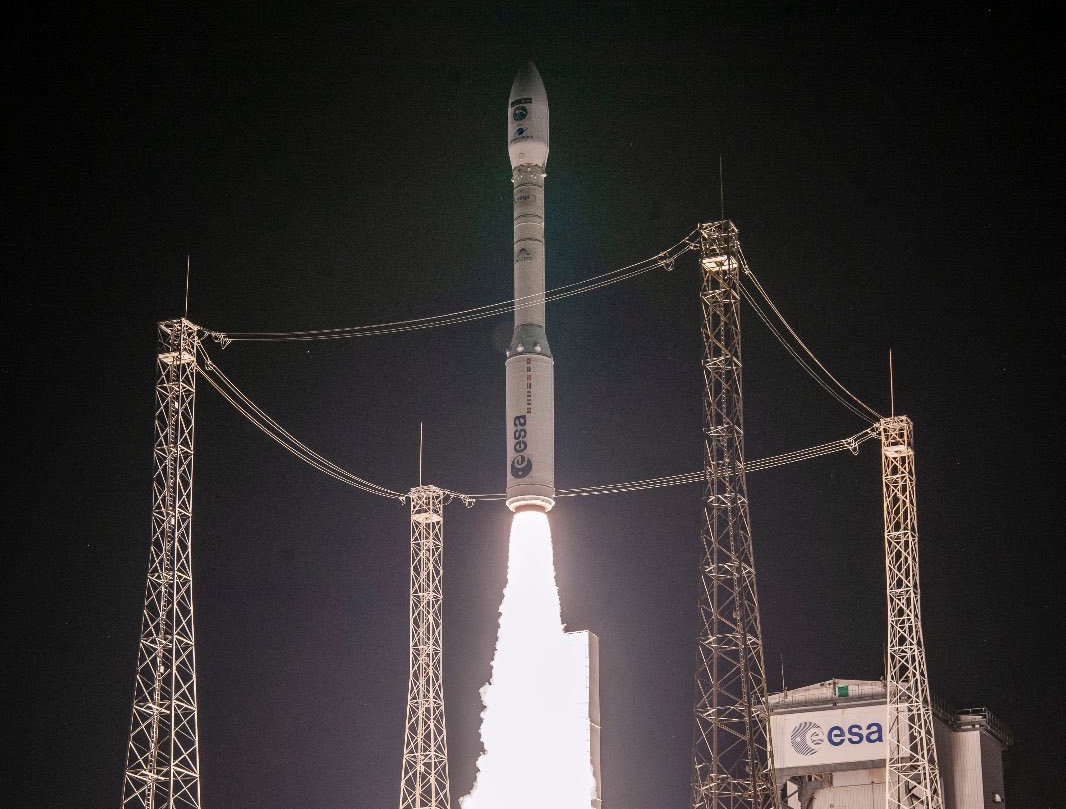WASHINGTON — The final flight of the original version of Europe’s Vega rocket successfully placed an Earth observation satellites into orbit Sept. 4.
The Vega rocket lifted off from the European spaceport at Kourou, French Guiana, at 9:50 p.m. Eastern. The launch was delayed a day because of an electrical issue with ground systems that halted the countdown a few hours before the scheduled liftoff time.
Vega deployed its payload, the Sentinel-2C satellite, into a sun-synchronous orbit at an altitude of about 775 kilometers nearly an hour after liftoff.
Sentinel-2C is a 1,143-kilogram spacecraft built by Airbus Defence and Space for the Copernicus Earth observation program of the European Commission and European Space Agency. The spacecraft carries a camera that provides imagery in 13 visible and shortwave infrared bands at a resolution of 10 meters.
Data from Sentinel-2C will be used for a variety of Earth observations applications. “It was an optical mission conceived initially to support requirements that were coming from the land” such as forestry and agriculture, said Simonetta Cheli, director of Earth observation programs at ESA, of the overall Sentinel-2 program at an Aug. 29 briefing. However, Sentinel-2 imagery has found uses elsewhere, from bathymetry to methane monitoring.
Sentinel-2C will ultimately replace Sentinel-2A, launched in 2015 and nearing the end of its design life. A fourth satellite, Sentinel-2D, is slated to launch in 2028 to replace Sentinel-2B and provide continuity for the program into the 2030s.
A next-generation satellite, Sentinel-NG, is under study that Cheli said could offer improved spatial resolution and more spectral bands. ESA plans to seek approval from its member states at the 2025 ministerial conference to begin work on that program.
The launch was the 22nd and final flight of the original Vega vehicle, which made its introduction in 2012. The vehicle had a perfect record until its 15th launch in July 2019, when the rocket’s second stage suffered a malfunction that led to the loss of a UAE reconnaissance satellite. Two flights later, a second Vega rocket failed in November 2020 when improperly connected cables caused a loss of control of its liquid-propellant upper stage.
The Vega is being phased out in favor of the more powerful Vega C, which made its introduction in July 2022. However, the rocket’s second launch in December 2022 failed due to a flaw in the nozzle of its Zefiro-40 second stage motor, which is not used on the original Vega.
The Vega C has yet to resume launches, but is scheduled to return to flight in November, carrying the Sentinel-1C radar imaging satellite. Toni Tolker-Nielsen, ESA’s director of space transportation, said at the Aug. 29 briefing that a final static-fire test of the motor and its new nozzle is scheduled for October.
“There is very good confidence,” he said, “that this test in the beginning of October will be successful.” That is based on a previous, successful test of the redesigned motor in May.
If the upcoming test is successful, he said the Vega C should make its return to flight in late November. That date, he said, has held firm for more than a year as the Zefiro-40 motor was redesigned and tested. “We’ve been following a plan that was set out in the middle of last year and I’m very confident that we will be able to make it with Vega C’s return in the end of November.”
Assuming a successful return to flight for Vega C, Tolker-Nielsen said the vehicle will ramp up to four launches in 2025 and five in 2026 and beyond.
The launch also marks a beginning of transition in launch services responsibilities between Arianespace and Avio, the prime contractor for Vega and Vega C. Stéphane Israël, chief executive of Arianespace, said at the briefing his company will handle launch services through the VV29 launch late next year; this launch was designated VV24. Avio will then take over launch services from Arianespace.
“We will discuss with the different customers, starting with the European Commission, regarding the handover of these contracts in a fully cooperative mode,” he said. Avio took over commercialization of the Vega C at the beginning of September, he said. “Arianespace is not in charge any more of selling and marketing Vega, however, we are fully in charge of the operation of Vega up to VV29.”
Related
Read the original article here


